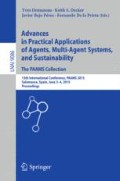Abstract
This paper highlights the use of Situated Artificial Institution (SAI) within an hybrid, interactive, normative multi-agent system to regulate human collaboration in crisis management. Norms regulate the actions of human actors based on the dynamics of the environment in which they are situated. This dynamics result both from environment evolution and actors actions. Our objective is to couple norms to environment state to provide a context aware crisis regulation. Introducing a constitutive level between environmental and normative states provides a loosely coupling of norms with the environment. Norms are thus no more referring to environmental facts but to status functions, i.e. institutional interpretation of environmental facts through constitutive rules. We present how this declarative and distinct SAI modelling succeeds in managing the interpretation of the events while taking into account organizational context.
Access this chapter
Tax calculation will be finalised at checkout
Purchases are for personal use only
Preview
Unable to display preview. Download preview PDF.
References
Aldewereld, H., Napagao, S.Á., Dignum, F., Vázquez-Salceda, J.: Making norms concrete. In: van der Hoek, W., Kaminka, G.A., Lespérance, Y., Luck, M., Sen, S. (eds) AAMAS 2010, pp. 807–814 (2010)
Boella, G., van der Torre, L., Verhagen, H.: Introduction to the special issue on normative multiagent systems. Autonomous Agents and Multi-Agent Systems 17(1), 1–10 (2008)
de Brito, M., Hübner, J.F., Bordini, R.H.: Programming institutional facts in multi-agent systems. In: Aldewereld, H., Sichman, J.S. (eds.) COIN 2012. LNCS, vol. 7756, pp. 158–173. Springer, Heidelberg (2013)
Campos, J., López-Sánchez, M., Rodríguez-Aguilar, J.A., Esteva, M.: Formalising situatedness and adaptation in electronic institutions. In: Hübner, J.F., Matson, E., Boissier, O., Dignum, V. (eds.) COIN 2008. LNCS, vol. 5428, pp. 126–139. Springer, Heidelberg (2009)
Dastani, M., van der Torre, L., Yorke-Smith, N.: Monitoring interaction in organisations. In: Aldewereld, H., Sichman, J.S. (eds.) COIN 2012. LNCS, vol. 7756, pp. 17–34. Springer, Heidelberg (2013)
de Brito, M., Hübner, J.F., Boissier, O.: A conceptual model for situated artificial institutions. In: Bulling, N., van der Torre, L., Villata, S., Jamroga, W., Vasconcelos, W. (eds.) CLIMA XV. LNCS, vol. 8624, pp. 35–51. Springer, Heidelberg (2014)
Dugdale, J., Bellamine-Ben Saoud, N., Pavard, B., Pallamin, N.: Simulation and emergency management. In: Van de Walle, B., Turoff, M., Hiltz, S.R. (eds.) Information Systems for Emergency Management. Advances in Management Information Systems 2010. Part IV. Systems Design and Technology (Chap. 10), vol. 16. M.E. Sharpe (2010)
Ferraris, C., Martel, C.: Regulation in groupware: the example of a collaborative drawing tool for young children. In: CRIWG 2000, pp. 119–127 (2000)
Franke, J., Charoy, F.: Design of a collaborative disaster response process management system. In: 9th International Conference on the Design of Cooperative Systems (2010)
Garbay, C., Badeig, F., Caelen, J.: Normative multi-agent approach to support collaborative work in distributed tangible environments. In: Poltrock, S.E., Simone, C., Grudin, J., Mark, G., Riedl, J. (eds.) CSCW 2012, pp. 83–86. ACM (2012)
Grossi, D., Aldewereld, H., Vázquez-Salceda, J., Dignum, F.: Ontological aspects of the implementation of norms in agent-based electronic institutions. Computational & Mathematical Organization Theory 12(2–3), 251–275 (2006)
Kubicki, S., Lepreux, S., Kolski, C.: Rfid-driven situation awareness on tangisense, a table interacting with tangible objects. Personal and Ubiquitous Computing 16(8), 1079–1094 (2012)
Oh, J., Meneguzzi, F., Sycara, K., Norman, T.J.: An agent architecture for prognostic reasoning assistance. In: IJCAI 2011, pp. 2513–2518. AAAI Press (2011)
Oomes, A.H.J.: Oragnization awareness in crisis management. In: ISCRAM (2004)
Pipek, V., Liu, S.B., Kerne, A.: Crisis informatics and collaboration: a brief introduction. CSCW 23(4–6), 339–345 (2014)
Piunti, M., Boissier, O., Hübner, J.F., Ricci, A.: Embodied organizations: a unifying perspective in programming agents, organizations and environments. In: MALLOW 2010, CEUR, vol. 627 (2010)
Robert, J.M.: Cognition située, cognition distribuée et cognition socialement partagée. Cours (2012)
Searle, J.: Making the Social World: The Structure of Human Civilization. Oxford University Press (2009)
Shaer, O., Hornecker, E.: Tangible user interfaces: Past, present, and future directions. HCI 3, 1–137 (2010)
Thévin, L., Badeig, F., Dugdale, J., Boissier, O., Garbay, C.: Un système multi-agent normatif pour la collaboration et l’interaction mixte. In: JFSMA 18, pp. 1–10 (2014)
Vasconcelos, W.W., Kollingbaum, M.J., Norman, T.J.: Normative conflict resolution in multi-agent systems. Autonomous Agents and Multi-Agent Systems 19(2), 124–152 (2009)
Zhang, S., Gu, N., Yang, J.: An norm-driven state machine model for cscw systems. Expert Systems with Applications 31(4), 800–807 (2006)
Author information
Authors and Affiliations
Corresponding author
Editor information
Editors and Affiliations
Rights and permissions
Copyright information
© 2015 Springer International Publishing Switzerland
About this paper
Cite this paper
De Brito, M., Thevin, L., Garbay, C., Boissier, O., Hübner, J.F. (2015). Situated Artificial Institution to Support Advanced Regulation in the Field of Crisis Management. In: Demazeau, Y., Decker, K., Bajo Pérez, J., de la Prieta, F. (eds) Advances in Practical Applications of Agents, Multi-Agent Systems, and Sustainability: The PAAMS Collection. PAAMS 2015. Lecture Notes in Computer Science(), vol 9086. Springer, Cham. https://doi.org/10.1007/978-3-319-18944-4_6
Download citation
DOI: https://doi.org/10.1007/978-3-319-18944-4_6
Published:
Publisher Name: Springer, Cham
Print ISBN: 978-3-319-18943-7
Online ISBN: 978-3-319-18944-4
eBook Packages: Computer ScienceComputer Science (R0)

